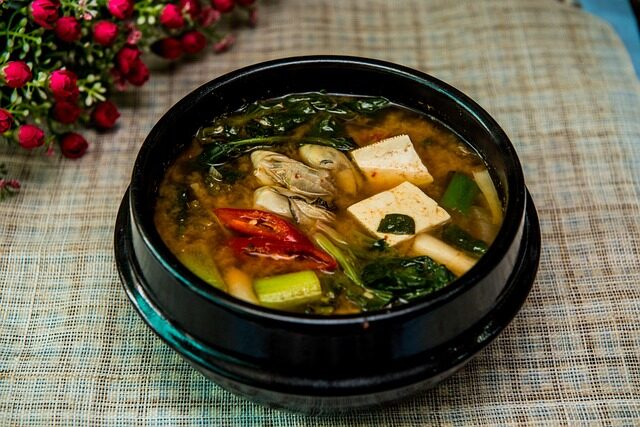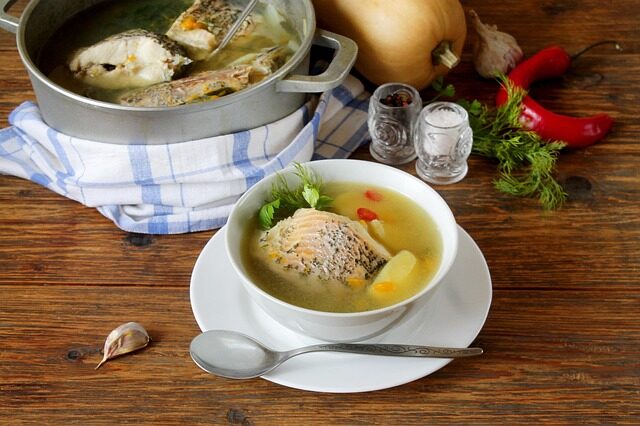Discovering the hearty flavors and traditions of Norway’s culinary landscape leads us to Småsuppe, a rustic soup from southern Norway. This wholesome dish is not just a testament to the simplicity of Nordic cuisine but also a celebration of foraging and local ingredients.
In the serene backdrop of southern Norway, where the fjords mirror the skies and the land whispers tales of yore, there’s a soup that embodies the essence of the region’s soulful cooking. Småsuppe is not just food; it’s a narrative of tradition, nature, and the warmth of Norwegian hospitality.
What is Småsuppe?
Originating from the verdant lands of southern Norway, Småsuppe is a traditional delicacy known for its rich and earthy flavors. It is a cornerstone of Norwegian culinary traditions, often enjoyed during the colder months. Småsuppe’s charm lies in its simplicity and its reliance on fresh, local ingredients that capture the very essence of Scandinavian recipes.
At the heart of Småsuppe is the celebration of seasonality. The soup is typically made with whatever ingredients are available during the season, making it a versatile dish that changes with the landscape. It is comfort food that brings together families, warming them with its nourishing broth.
Småsuppe is more than just a meal; it’s a ritual that honors the natural bounty of the land. It’s a way for Norwegians to connect with their roots and enjoy the fruits of their labor after a day of foraging in the wild.

What Are the Ingredients for Småsuppe?
The ingredients for Småsuppe are as varied as the Norwegian seasons but are always centered around what the earth provides. The base of the soup typically consists of a rich stock, root vegetables, and herbs.
- Wild mushrooms
- Leeks or onions
- Carrots and potatoes
- Seasonal greens like kale
- Fresh herbs such as thyme and bay leaves
However, the true magic of Småsuppe lies in the foraged elements. Depending on the season, foragers might add foraged ingredients for soups like spruce tip sugar or dandelion syrup, which bring unique flavors and a touch of the wild to this comforting soup.
How To Make Traditional Småsuppe?
Creating Småsuppe involves a few essential steps that highlight the patience and care of traditional Norwegian cooking. Starting with a flavorful base, the soup is built up with layers of texture and taste as each ingredient is given the time to meld together harmoniously.
- Begin with a solid base: sauté onions or leeks until soft.
- Add your broth and bring to a gentle simmer.
- Include your hardy vegetables like carrots and potatoes.
- Forage for extras: if available, add wild ingredients.
- Season with herbs and let the soup cook slowly, allowing the flavors to deepen.
Remember, the key to authentic Småsuppe is patience and the use of the freshest ingredients possible. Each household may have its own variation, but the essence of the dish remains rooted in simplicity and the taste of Norwegian nature.
What Are The Benefits Of Foraging Ingredients For Småsuppe?
Foraging for Småsuppe ingredients is not just a means to an end; it’s a holistic practice that benefits both the environment and the forager. The act of foraging encourages a sustainable approach to cooking, where only what is needed is harvested, ensuring that nature can continue to thrive.

Foraging contributes to biodiversity, as it promotes the growth of varied plant species and fosters a deeper appreciation for the natural world. It also allows for a more nutritious soup, as wild ingredients often contain higher levels of vitamins and minerals than their cultivated counterparts.
The process of foraging itself can be therapeutic, serving as a connection to the land and a form of physical activity. It is a tradition that has been passed down through generations, retaining cultural significance and knowledge of the land.
How Does Småsuppe Compare To Other Norwegian Soups?
Norway is renowned for its array of soups, each with distinctive ingredients and preparation methods. While traditional Norwegian soups like yellow pea soup or Jerusalem artichoke soup have their own unique flavors and textures, Småsuppe stands out for its emphasis on foraged ingredients and its deep connection to nature.
Unlike many other soups that have a set recipe, Småsuppe is more flexible, allowing for variations based on what the land provides. This not only creates a unique dining experience with each preparation but also showcases the versatility of Norwegian comfort food in the Nordic cuisine spectrum.
What Variations Exist For Småsuppe?
While the core concept of Småsuppe is consistent, its execution can differ greatly from one cook to another. Some may prefer a thicker, stew-like consistency, while others might opt for a lighter broth.

- Vegetarian versions with a variety of seasonal vegetables
- Inclusion of meats such as reindeer or elk for a heartier dish
- Use of different herbs and spices to change the flavor profile
No matter the variation, the essence of Småsuppe as a rustic and heartwarming soup remains. It is a canvas for culinary creativity, rooted in the traditions and flavors of southern Norway.
What Is The Cultural Significance Of Småsuppe In Norway?
The cultural significance of Småsuppe in Norway runs deep. It’s a dish that embodies the Norwegian spirit of resilience and resourcefulness, utilizing whatever the land offers to create something warm and satisfying.
It is common to see Småsuppe served at family gatherings, where it acts as a centerpiece, bringing loved ones together over a shared meal. The practice of making Småsuppe is a way of preserving Norwegian culinary traditions, ensuring they continue to be a part of the fabric of everyday life.
As we delve into the storied past of Småsuppe, we learn that this rustic soup is more than just sustenance; it is a representation of Norway’s history, its connection to the land, and the importance of community.
As you explore the rich tapestry of Norwegian cuisine, take a moment to appreciate the simplicity and depth of Småsuppe, a rustic soup from southern Norway, and its place in the heart of Norwegian culture.


